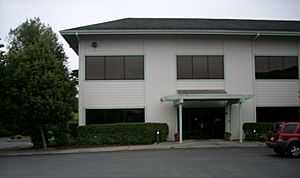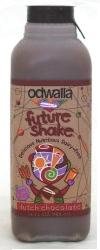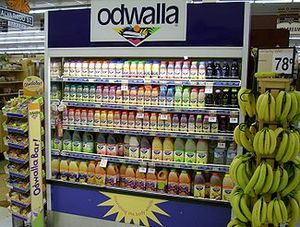Odwalla facts for kids
| Wholly owned subsidiary | |
| Industry | Consumer products |
| Founded | 1980 Santa Cruz, California, U.S. |
| Founder |
|
| Defunct | July 2020 |
| Headquarters | Half Moon Bay, California, U.S. |
|
Area served
|
United States |
|
Key people
|
Steven M. McCormick, COO and General Manager James R. Steichen, SVP Finance and CFO Chris Brandt, Director Brand |
| Products | Drinks, food bars, chips |
| Revenue | US$187.9 million (2007) |
|
Number of employees
|
900 |
| Parent | Minute Maid, a division of The Coca-Cola Company |
Odwalla Inc. was an American company that sold fruit juices, smoothies, and food bars. It started in Santa Cruz, California in 1980. From 1995 to 2020, its main office was in Half Moon Bay, California. Odwalla made many products like juices, smoothies, soy milk, and special "food bars."
The company grew quickly after it officially became a business in 1985. It started selling its products across most of North America. In 1993, Odwalla became a public company, meaning its shares could be bought and sold.
However, the company faced a big challenge in 1996. There was a serious health issue caused by E. coli bacteria in some of its apple juice. This happened because bruised fruit was used. Odwalla used to sell juices that were not pasteurized. They believed pasteurization changed the taste. After the E. coli issue, Odwalla started using flash pasteurization and other cleaning methods. The company recalled its juices, and sales dropped a lot. But Odwalla slowly recovered and became profitable again the next year.
In 2001, The Coca-Cola Company bought Odwalla for $181 million. Odwalla then became a part of Coca-Cola. In July 2020, Coca-Cola announced it would stop selling Odwalla products. The brand was later sold to another company in 2021.
Contents
History of Odwalla
How Odwalla Started
Odwalla was started in Santa Cruz, California, in 1980. The founders were Greg Steltenpohl, Gerry Percy, and Bonnie Bassett. They got the idea to sell fruit juices from a business book. They began by squeezing orange juice in a shed in Greg Steltenpohl's backyard.
They sold their juices from the back of a Volkswagen van to local restaurants. Their slogans included "soil to soul, people to planet and nourishing the body whole." The name "Odwalla" came from a song-poem. It was about a character who helped people escape a "gray haze." The founders felt this related to their products. They believed their juices helped people avoid "over-processed foods."
Growth and Challenges

Odwalla officially became a company in September 1985. It grew and began selling products in San Francisco by 1988. A company called Hambrecht & Quist invested several million dollars in Odwalla. By 1992, Odwalla had 80 employees and sold about 20 juice flavors.
In December 1993, Odwalla became a public company. This meant people could buy shares of the company. At this time, Odwalla had 35 delivery trucks and almost 200 employees. It made about $13 million a year. Odwalla then expanded by buying two other companies.
In 1994, Odwalla built a new production place in Dinuba, California. This helped them make more juice. The next year, the company moved its main office to Half Moon Bay, California. Odwalla's sales grew a lot during these years. From 1994 to 1995, its income tripled. In 1996, they made over $59 million in sales. This growth made Odwalla one of the biggest fresh-juice companies in America. Many people thought Odwalla's products were healthier because they were not pasteurized.
Overcoming Difficulties and New Products
On October 7, 1996, Odwalla used some bruised fruit to make apple juice. This juice became contaminated with E. coli bacteria. This incident caused one death and made 66 customers sick. Odwalla had been selling juices that were not pasteurized.
Even with a loss in 1997, Odwalla worked to improve its image. They advertised their new safety steps. Odwalla also released its first solid food product: food bars. They entered the large market for fruit bars. Another new product was the Future Shake, a "liquid lunch" for younger people. Because of these efforts, Odwalla became profitable again by the end of 1997.
After recovering, the company expanded to new areas like Philadelphia and Washington, D.C.. By the end of 1998, their sales were higher than before the incident. Growth continued, partly because they bought Fresh Samantha in 2000. Fresh Samantha was a big juice company in Saco, Maine. This helped Odwalla sell more on the East Coast. However, shipping products across the country was expensive. Odwalla planned to build a second factory in Palm Beach County, Florida. But this plan was later canceled.
In 2001, The Coca-Cola Company bought Odwalla for $181 million. Odwalla's leaders stayed in charge of the company. This purchase helped Coca-Cola add more non-carbonated drinks to its products. Odwalla benefited from Coca-Cola's strong distribution network. This helped Odwalla reach new markets.
Odwalla continued to grow after being bought by Coca-Cola. They released new products like PomaGrand pomegranate juice and "Soy Smart" drinks. These soy drinks had soy protein, omega-3 fatty acids, and calcium. In 2006, Coca-Cola promoted Odwalla products in schools. This was part of a plan to remove sugary sodas from schools. Odwalla continued to do well in 2007.
In July 2020, Coca-Cola announced it would stop selling all Odwalla products. They called Odwalla one of their "zombie brands." These were brands that made up less than 2% of their total sales.
How Odwalla Made Products
Odwalla used fresh fruits and vegetables to make many of its products. They also used organic oats for food bars. Some juices were only available during certain seasons. The amount and price of fruit could change due to weather or disease. Because of this, Odwalla juice colors and flavors changed slightly throughout the year.
After the E. coli issue, Odwalla made its production safer. First, fruits were washed, sorted, and cleaned before entering the factory. Then, apples, carrots, and citrus fruits were washed again. The fruit was pressed to get the juice. This juice was then flash pasteurized and put into bottles. A sample of each batch was tested for quality. If it passed, the juice was sent in refrigerated trucks to stores.
Odwalla juice had a short shelf life and needed to be kept cold. However, its shelf life became longer after flash pasteurization was introduced in 1996. A new plastic bottle in 2001 also helped. Odwalla products were often sold in special Odwalla-brand displays in stores. This helped customers easily find them.
Odwalla Products
Drinks
Odwalla Inc. made many kinds of fruit and vegetable drinks. They also sold dairy-free soy milk called "Soy Smart." Other drinks included "PomaGrand" pomegranate juice and "Serious Energy" caffeinated fruit juice. They also sold bottled spring water. Odwalla's "Superfood" smoothies were very popular. These were made from fruit purées, wheat grass, and barley grass. These drinks made up about 95% of Odwalla's sales in 2001.
Odwalla juice was sold in individual 12 fl oz (about 355 ml) bottles. These bottles were made of plant-based, recyclable HDPE plastic. Larger 64 US fluid ounce (about 1.9 liter) containers were also available. Odwalla juice was usually more expensive than other juices. Its price could change based on the cost of fruits and vegetables.
Odwalla's drinks sometimes had a lot of sugar. For example, Odwalla's "Mango Tango" had more sugar per ounce than Coca-Cola. A 12-ounce "Mango Tango" had 44 grams of sugar. This is almost four tablespoons of sugar. Over time, Odwalla stopped selling some juice flavors that were not as popular. These included Amazing Purple, Soy Vanilla, and Pomegranate Mango drinks.
Food Bars
In September 1998, Odwalla started selling energy bars. These were made with fruit and grains and called "food bars." They were an alternative to their drinks. This was an effort to increase sales after the 1996 E. coli issue. The first three flavors were Cranberry Citrus, Organic Carrot & Raisin, and Peach Crunch.
Within eight weeks, Odwalla Bars became one of the best-selling energy bar brands. The bars came in many flavors. Each bar weighed 2 ounces (about 56 grams). In 2001, before Coca-Cola bought Odwalla, food bars made up less than five percent of Odwalla's sales.
See also
 In Spanish: Odwalla Inc. para niños
In Spanish: Odwalla Inc. para niños




